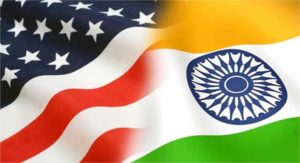India and the United States of America (USA) have established a new two plus two (2 + 2) ministerial dialogue to enhance strategic coordination between them and for maintaining peace and stability in the Indo-Pacific region. It is similar to the India-Japan 2+2 dialogue format but pitched at ministerial and not an official level. The new format fixed for its maiden meeting on 06th Sep 2018 would involve meeting between Defence Secretary James Mattis and Secretary of State Mike Pompeo with Foreign Minister Sushma Swaraj and Defence Minister Nirmala Sitharaman. This is meant to replace the ‘Strategic and Commercial Dialogue’ between the foreign and commerce ministers of the two countries that was held during the previous Obama administration.
The blueprint of this dialogue envisions “strengthening strategic, security and defence cooperation” between the two countries and to coordinate more closely on Afghanistan, developments in the Asia Pacific, Indian Ocean and also in the Middle East (West Asia). The dialogue is also aligned to insulate the India-US strategic relationship from feuds over trade and the deep divide on economic integration policies.
Decoding Concerns of India & USA
For India, the moot point with US amidst a number of irritants would be: trade, tariff rates, US sanctions on Russia and Iran and signing of Communications Compatibility and Security Agreement (COMCASA) and Basic Exchange and Cooperation Agreement (BECA). The other anticipated issues for discussion by India are China-Pakistan nexus and its effect on the region to include CPEC, Gwadar Port, PLA Base in Skardu, FATA, and Afghanistan. Secondly, free-run by Pakistan Haqqanis & support to Taliban, LeT, JuD, HuM etc. Lastly, linking of US aid to Pakistan with a caveat to close anti-India terrorist camps in Pakistan.
US, on the other hand, would possibly be interested in: cooperation on the high seas of Indo-Pacific Region and developments in West Asia. The current situation and Pakistan’s terror export in Afghanistan. Concerns over Chinese expansionism in the Indian Ocean and India-US Defence cooperation. Finally, not to miss out inquisitiveness and uneasiness of US on recently held Modi-Xi and Modi-Putin informal meets which surely would be brought on the table by the US.
Since the US has designated India as a Major Defence Partner in 2016 and has highlighted US-India strategic partnership in the US President’s National Security Strategy and the administration’s South Asia and Indo-Pacific strategies, it is expecting easier procurement of American weapons and the transfer of sophisticated technologies to India. For long, the US has also been pushing India to sign the two agreements — COMCASA and BECA. The third agreement, India signed in 2016 — Logistical Exchange Memorandum of Agreement (LEMOA), which has since been operationalised.
India still stands unsure of these agreements with a belief that COMCASA and BECA are likely to harm India’s strategic interests by binding India to tow the US interests. On the contrary, the keenness and eagerness of India to purchase military systems like drones, helicopters etc. from the US would purely depend on India signing these agreements. As strategic & economic interests of India on such issues don’t converge, it is creating a decision dilemma for Indian policy makers.
Another interesting and contentious issue surely to be discussed is US keenness to ensure total isolation of Iran for which it expects India to help. The Iran message was delivered very clearly by Nikki Haley, United States Ambassador to the United Nations, during her recent visit to New Delhi. In this regard, the US wants India to stop the purchase of oil from Iran. During the Obama years, India was required to bring down oil imports at an average rate of 20 percent every six months. But Trump has been insisting that this has to go down to “Nil”.
Analysing the Issues
There seems to be a visible skepticism in US about Modi’s stance. Post Wuhan summit, Washington believes that India is making too much accommodation for too little return. India’s signaling to China on regional issues has concerned many in the US while China, just a few days before the dialogue on 29th Aug, added fuel to the fire by describing India a natural partner in its Belt and Road Initiative (BRI). Also, India’s recent indifferent stance on Quad, despite its concerns about China’s growing footprint in its immediate neighbourhood and retaliatory tariff war on US has also baffled US policy thinkers. Washington believes that shift is probably because India doesn’t want to complicate its relations with China any further, especially heading into the next general election. This is likely to fuel fodder to anti-India lobby in the US, especially after Mattis worked hard to get India a waiver from the Russia sanctions law – not an easy task given the anti-Russia sentiment in the US Congress. Sanctions on India over Iran similarly, is anticipated to be delayed or managed during this dialogue. On the trade front, the US Commerce Department has given India Strategic Trade Authorisation-1 status, bringing it on par with NATO countries.
Though these strategic and economic leverages by US are encouraging and suit India’s needs, but they are yet to be time tested. Probably India did not anticipate these so soon, driving them in its present state of ‘Strategic Neutrality.’ The likely rationale for this stance could be that India is not positing itself neutrally, but is actively seeking greater collaboration on economic, security and political fronts with other countries as well as keeping its options open with other major powers for a better bargaining chip. India however, needs to finally decide and commit.
India needs to convey its strategic and economic compulsions to US, mainly on Iran and Indo-Russian defence deals. India should also make the US aware about its relevance to the US-Afghanistan strategy.
To conclude, time will only tell how India balances its relationship with the US without damaging its ties with other players but India needs to emphatically convey to the US that such dialogues need to be without any preconditions. Failing to do so, may only further vitiate the rapport between the two countries.
Courtesy: http://www.claws.in/1929/india-us-22-dialogue-skepticism-and-hope-col-rajeev-kapoor.html





